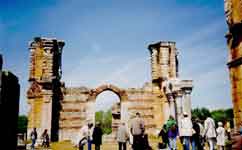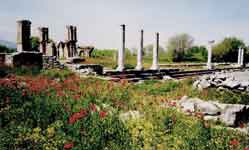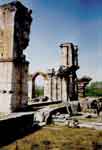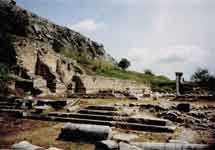.
Periphery: East Macedonia and Thrace
Prefecture : Kavala

Map of Greece showing Philippi or Philippoi
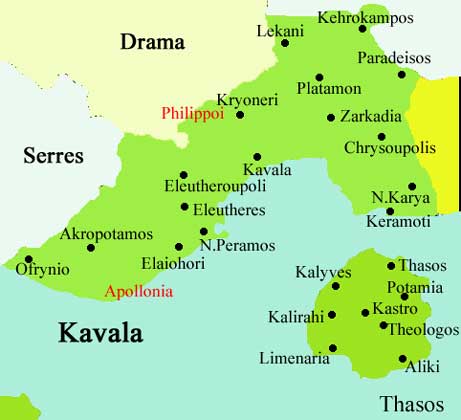
Philippi in the prefecture of Kavala
Philippi (in Ancient Greek Φἱλιπποι/ Philippoi) was a city in eastern Macedonia, founded by Philip II in 356 BC and abandoned in the 14th century after the Ottoman conquest.
Origins
Philippi was founded by the king of Macedon, Philip II, on the site of the Thasian colony of Crenides (Κρηνἱδες, "Fountains"), near the head of the Aegean Sea at the foot of Mt. Orbelos (the modern Mt. Lekani), about 13 km north-west of Kavala, on the northern border of the marsh that in Antiquity covered the entire plain separating it from the Pangaion hills to the south.
The objective of founding the town was to take control of the neighbouring gold mines and to establish a garrison at a strategic passage: the site controlled the route between Amphipolis and Neapolis, part of the great royal route which crosses Macedonia from the east to the west and which was reconstructed later by the Roman Empire as the Via Egnatia. Philip II endowed the new city with important fortifications, which partially blocked the passage between the swamp and Mt. Orbelos, and sent colonists to occupy it. Philip also had the marsh partially drained, as is attested by the writer Theophrastus. Philippi preserved its autonomy within the kingdom of Macedon, and had its own political institutions (the Assembly of the demos). The discovery of new gold mines near the city, at Asyla, contributed to the wealth of the kingdom, and Philip established a mint there. The city was finally fully integrated into the kingdom under Philip V.
The city remained despite its modest size of perhaps 2000 people. When the Romans destroyed the Antigonid dynasty of Macedon in 167 BC and divided it into four separate states (merides), it was Amphipolis and not Philippi that became the capital of the eastern Macedonian state.
Almost nothing is known about the city in this period, aside from the walls, the Greek theatre, the foundations of a house under the Roman forum, and a little temple dedicated to a hero cult. This monument covers the tomb of a certain Exekestos, is possibly situated on the agora, and is dedicated to the κτίστης (ktistès), the foundation hero of the city.

Philippi's forum and basilica B seen from the acropolis.[Source]
The Roman era
The city reappears in the sources during the Roman civil war that followed the assassination of Julius Caesar. His heirs Mark Antony and Octavian confronted the assassins of Caesar, Marcus Junius Brutus and Cassius, at the Battle of Philippi in the plain to the west of the city in October, 42 BC. Antony and Octavian were victorious in this final battle against the partisans of the Republic. They released some of their veteran soldiers, probably from legion XXVIII, and colonized them in the city, which was refounded as Colonia Victrix Philippensium. In 30 BC, Octavian became Roman emperor, reorganized the colony, and established more settlers there, veterans possibly from the Praetorian Guard and other Italians. The city was renamed Colonia Iulia Philippensis, and then Colonia Augusta Iulia Philippensis after January, 27 BC, when Octavian received the title Augustus from the Roman Senate.
Following this second renaming, and perhaps after the first, the territory of Philippi was centuriated (divided into squares of land) and distributed to the colonists. The city kept its Macedonian walls, and its general plan was modified only partially by the construction of a forum, a little to the east of the site of Greek agora. It was a "miniature Rome," under the municipal law of Rome and governed by two military officers, the duumviri, who were appointed directly from Rome.
The colony recognized its dependence on the mines that brought it its privileged position on the Via Egnatia. This wealth was shown by the many monuments that were particularly imposing considering the relatively small size of the urban area: the forum, laid out in two terraces on both sides of the main road, was constructed in several phases between the reigns of Claudius and Antoninus Pius, and the theatre was enlarged and expanded in order to hold Roman games. There is an abundance of Latin inscriptions testifying the prosperity of the city.
In 49 or 50 AD, the city was visited by the apostle Paul, who was supposedly guided there by a vision. Accompanied by Silas, Timotheus, and possibly Luke, the presumed author of the Acts of the Apostles, he preached for the first time on European soil in Philippi, and baptized Lydia, a purple dye merchant, in a river to the west of the city. At this time there was also a Jewish community and a synagogue, attested by inscriptions.
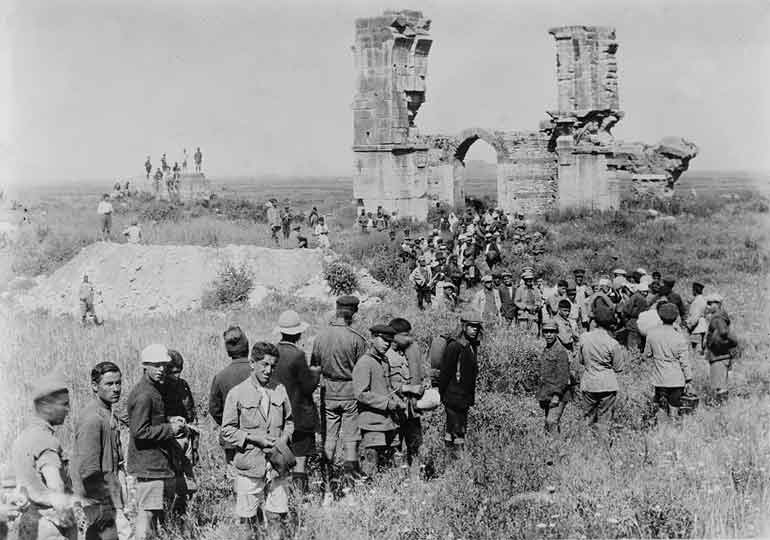
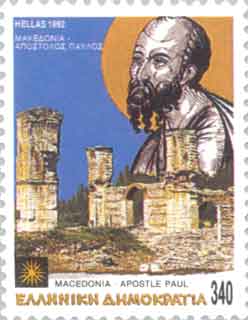
Apostle Paul in Macedonia
Paul visited the city on two other occasions, in 56 and 57. The Epistle to the Philippians dates from around 54-55 and shows the immediate impact of Paul's preaching. The subsequent development of Christianity in Philippi is well-attested, notably by a letter from Polycarp of Smyrna addressed to the community in Philippi around 160, and by funerary inscriptions.
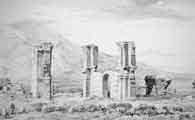
The early Christian era
Basilica B, seen from the southwest, and the acropolis in the background.
The first church attested in the city is a small building that was probably originally a small prayer house. This Basilica of Paul, identified by an mosaic inscription on the pavement, is dated around 343 from a mention by the bishop Porphyrios, who was present at the Council of Serdica that year.
Inscription of Bishop Porphyrios in the Basilica of Paul.
Although there is neither archaeological nor literary evidence for the foundation of the Christian community by Paul, the prosperity of the city in the 5th and 6th centuries was attributed to him and to his martyr cult. As in other cities, many new ecclesiastical buildings were constructed at this time. Seven different churches were constructed in Philippi between the mid-4th century and the end of the 6th, some of which competed in size and decoration with the most beautiful buildings in Thessalonica, or even those of Constantinople. The relationship of the plan and of the architectural decoration of Basilica B with Hagia Sophia and Saint Irene in Constantinople accorded a privileged place to this church in the history of early Christian art. The complex cathedral which took the place of the Basilica of Paul at the end of the 5th century, constructed around an octagonal church, also rivaled the churches of Constantinople.
In the same age, the fortifications of the city were rebuilt in order to better defend against the growing instability in the Balkans. In 473, the city was besieged by the Ostrogoths, who were unable to take it but burned down the surrounding villages.
The Byzantine and Ottoman era
Already weakened by the Slavic invasions at the end of the 6th century, which ruined the agrarian economy of Macedon, and probably also by the Plague of Justinian in 547, the city was almost totally destroyed by an earthquake around 619, from which it never recovered. There was a small amount of activity there in the 7th century, but the city was now hardly more than a village.
The Byzantine Empire possibly maintained a garrison there, but in 838 the city was taken by the Bulgars under khan Isbul, who celebrated their victory with a monumental inscription on the stylobate in Basilica B, now partially in ruins. The site of Philippi was so strategically sound that the Byzantines attempted very soon to recapture it ca. 850. Several seals of civil servants and other Byzantine officials, dated to the first half of the 9th century, prove the presence of Byzantine armies in the city.
Around 969, Emperor Nicephorus II Phocas rebuilt the fortifications on the acropolis and in part of the city. These gradually helped weaken Bulgar power and strengthen the Byzantine presence in the area. In 1077, Bishop Basil Kartzimopoulos rebuilt part of the defenses inside the city. The city began to prosper once more, as witnessed by the Arab geographer Al Idrisi, who mentions it as a centre of business and wine production around 1150.
After a brief occupation by the Franks after the Fourth Crusade and the capture of Constantinople in 1204, the city fell into the hands of the Serbs. Still, it remained a notable fortification on the route of the ancient Via Egnatia; in 1354, the pretender to the Byzantine throne, Matthew Cantacuzenus, was captured there by the Serbs.
The city was abandoned at an unknown date, but when the French traveller Pierre Belon visited it in the 16th century, there were nothing but ruins, used by the Turks as a quarry. The name of the city was preserved at first by a Turkish village on the nearby plain, Philibedjik, which has since disappeared, and then by a Greek village in the mountains.
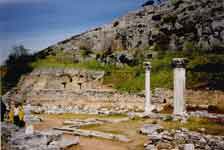
|
||
Archaeological excavation of the site
The ruins of Direkler (Basilica B), drawn by H. Daumet in 1861
Noted or briefly described by 16th century travellers, the first archaeological description of the city was made in 1856 by Perrot, then in 1861 by L. Heuzey and H. Daumet in their famous Mission archéologique de Macédoine. Nevertheless the first excavations did not begin until the summer of 1914, and were soon interrupted by the First World War. The excavations, carried out by the École française d'Athènes, were renewed in 1920 and continued until 1937. During this time the Greek theatre, the forum, Basilicas A and B, the baths, and the walls were excavated. After the Second World War, Greek archaeologists returned to the site. From 1958 to 1978 the Société Archéologique, then the Service archéologique and the University of Thessalonica uncovered the bishop's quarter and the octagonal church, large private residences, a new basilica near the Museum and two others in the necropolis to the east of the city.
References
Translated from the French Wikipedia article, retrieved February 11, 2005. That article, in turn, gives the following references:
P. Collart, Philippes ville de Macédoine de ses origines jusqu'à la fin de l'époque romaine, Paris, 1937. (In French.)
P. Lemerle, Philippes et la Macédoine orientale, Paris, 1945. (In French.)
M. Sève, "De la naissance à la mort d'une ville : Philippes en Macédoine (IVe siècle av. J.-C.–VIIe siècle apr. J.-C.)", Histoire urbaine n° 1, juin 2000, 187–204. (In French.)
Ch. Bakirtzis, H. Koester (ed.), Philippi at the Time of Paul and after His Death, Harrisburg, 1998. (In English.)
Ch. Koukouli-Chrysanthaki, Ch. Bakirtzis, Philippi Athens, second edition, 1997. (In English.)
G. Gounaris, E. Gounaris, Philippi: Archaeological Guide, Thessaloniki, 2004. (In Greek.)
Links
- Philippi - Catholic Encyclopedia
| Ancient Greece
Science, Technology , Medicine , Warfare, , Biographies , Life , Cities/Places/Maps , Arts , Literature , Philosophy ,Olympics, Mythology , History , Images Medieval Greece / Byzantine Empire Science, Technology, Arts, , Warfare , Literature, Biographies, Icons, History Modern Greece Cities, Islands, Regions, Fauna/Flora ,Biographies , History , Warfare, Science/Technology, Literature, Music , Arts , Film/Actors , Sport , Fashion --- |
Retrieved from "http://en.wikipedia.org/"
All text is available under the terms of the GNU Free Documentation License



